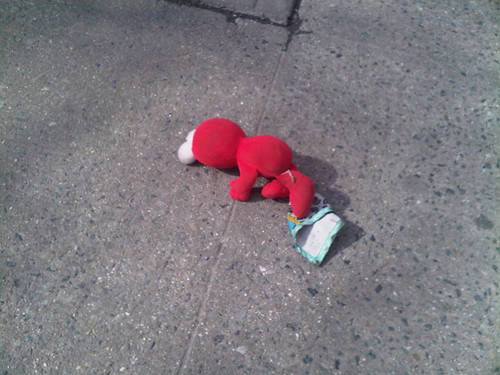Image Via
Continued from Part 1, posted on Thursday, Feb 10, 2011: “Making a Living as an Artist: With or Without a Dealer,” was organized and chaired by artist Sharon Louden, with the artist and writer Sharon Butler, artist, former gallery director, curator and current Director of the Elizabeth Foundation for the Arts Studio Program Bill Carroll; artist, curator and current Dean of The New York Academy of Art Peter Drake; and New York dealer, blogger and author of How to Start and Run a Commercial Art Gallery Ed Winkleman.
Sharon Louden: Once you’ve done your homework and figured out which galleries are appropriate for your work, how do you get their attention? Is it just about the work?
Ed Winkleman: Yes, it’s just about the work. Believe it or not. The best way to approach a gallery is through one of their artists, or through curators associated with that gallery. But it’s not just about finding the gallery that’s right for you, because the galleries also have to think in terms of balancing their programs.
Bill Carroll: Actually, it wasn’t just about the work. I wanted to know whether younger artists were real go-getters. Also, whether an older artist has a great reputation. And [things that matter]: teamwork, personalities, sharing strategies, collector lists, etc.
Sharon Butler: You need to get the gallery to notice you, not by sending them your work, but by creating a SCENE. By making your voice heard. Any effort you put into building the community will be rewarded. So: rather than trying to bust into someone else’s scene, make your own.
Peter Drake: Put yourself in the galleries’ shoes, behave professionally. Don’t send out “shot-gun” packages. It’s insulting. Do the research.
Sharon L: How do I do all these things? It’s too much! Teaching/working/self-promoting/developing community/working with my dealer: this is all under the umbrella of being an artist.
Sharon B: The key to having an active, creative life is to connect the things you want to do. Find the things you want to do, and do them.
Bill: I’m REALLY social — running a gallery was really about connecting the artists to the world. …Find ways to integrate the various creative things you do — it’s part of the deal.
Ed: Artists today have a HUGE advantage over previous generations because they can do much of these things at home, online, in their pajamas. … Regarding the idea of ‘artistic purity’ — being in your studio all the time — having a conversation about your art, that too is something artists really want, and it requires social skills.
Peter: Diversify what you do creatively. Any time your life changes, it will change your studio practice. You will need to adjust. Think of socially engaged models such as Hallwalls…
Image Via
Sharon L: I’m going to talk about New York. Is New York City IT? What is your opinion about that?? And if you want a gallery in NY but live out of town, how do you do that? How do NY galleries deal with, or do they work with artists from out of town?
Ed: We work with two artists who actually live in Bishkek, Kyrgyzstan (laughter). The art world is decentralizing more and more. New York is not what it was just a few years ago. Take, for example, the VIP Art Fair — it was entirely online. 139 of some of the world’s major galleries participated. We connected with collectors in Italy and elsewhere. We normally wouldn’t have. In terms of the art marketplace, this change is coming like a tidal wave.
Bill: Okay, but Chelsea has over 300 galleries — where else can you find that? Soho at its height had only ~150 galleries. Artists must connect and make a name for themselves in their own locales and territory. If you do that, ultimately some New York gallery WILL want to show you.
Sharon B: I want to go back to on of Ed’s earlier comments about having a gallery’s artist refer you: you NEED to work with the community around you. Create an exchange, make connections with artist communities in other cities and towns, rather than badger galleries.
Peter: If you’re going to be part of a global community you have to be proactive.
Ed: I’m with Bill on loving NYC — but if you look at some of the larger galleries, they are opening up spaces in other cities. Don’t put all your eggs in one basket.
Sharon Louden: What does “representation” mean these days?
Bill: When the art world was smaller, the relationships were much more personal. There were stipends. Dealers like Betty Parsons were situated somewhere between collectors and dealers [like patrons]. This is long over. As is the idea of a ‘life-long’ relationship.
Sharon L: That goes back to the idea of ‘parents’.
Ed: The stipend was an act of faith… also, there are so many galleries now, and so many of them run on a shoe-string budget. Forty or fifty years ago, this wasn’t the case. We have different models now.
Sharon L: What should the expectations be between artists and dealers?
Ed: That is a conversation you must have before you enter into the relationship. It’s really a case-by-case thing, depending on the artist an what kind of career they have.





Pingback: Making a Living as an Artist (With or Without a Dealer) – part 1 | 2011 CAA Annual Conference Blog
Great to see you at CAA the other day, Joy, and really informative post. I wouldn’t disagree w/ you at all about the route into a gallery being through one of their artists. Really nice found art in Wash Square Park, too, by the way!
“Rather than trying to bust into someone else’s scene, make your own.”
Couldn’t be said any better.
Thank you for that topic, hope it continues, best regards, Hans